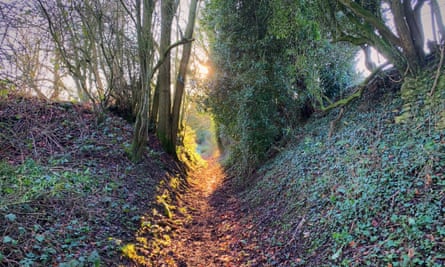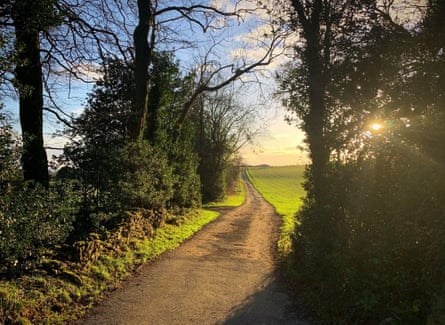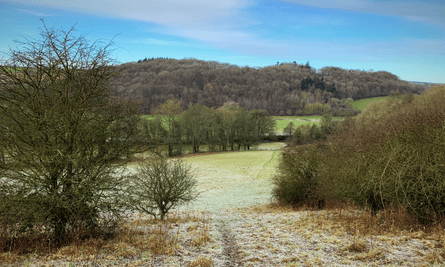It’s not lost on me, the irony of writing about mobility while sitting at my desk for hours, with a bent spine and cramped stomach. I’ve spent the last few years writing a book about past movement and mobility; footprints becoming trails that turn into a torrent of trods and roads.
My body wouldn’t allow for this stillness, so I went for walks. My lunchtime stroll was through a small wood on the top of the Chiltern hills, on the edge of the south Oxfordshire village where I lived at the time.
The woodland was rigidly and dramatically divided into two parts: the first two-thirds or so was beech and bluebell, and the rest, butting right up against this, was a different world made up of much younger planted conifers, such as larch and pine. The difference between these two elements within the same wood hit me every time: the beech packed with life and thick with understorey, the other hung with lichen and eerily silent. Even the light was different.
The path I took wound in and out among the trunks and through the horizontal layers of old and new parts. I would keep going until the path reached a farmer’s field on a steep scarp with views to a distant horizon, the cooling towers of Didcot power station dominating the middle ground – great, grey landmarks that have since been demolished.
At this point the path looped back through the woodland towards home.
I walked to shake out my legs and unfurl my body, and to maintain a daily connection with the world outside. Walking rejuvenates me, and over the years it has proved useful for working through my thoughts.
I did that walk hundreds of times, in all weathers and in different seasons. Each time, the woodland changed its feel, sometimes a little and sometimes a lot. I came to know its sounds and smells, whether the ground was covered in bluebells, summer shade, dry leaves or snow.
We had a special relationship, the path and me. Whether kicking up dust from sun-baked clay or squelching into rain-soaked mud, my feet have left their mark on it, and the path, in turn, has got deeply inside me. I’ve been shaped by the thoughts, feelings and physical exercise it made possible.
Paths are primary; their form built into our brain and part of our origin myth. Consequently, we rarely think about their origins; how they formed and where they came from. We don’t think of them as historic features, and tend not to consider the stories embedded in them. But when we do think about it, a hidden history is revealed, and something of the experience of our predecessors comes alive to us.

Paths are maintained by use, through trampling the ground. This compacts the soil and damages anything that grows. Grazing animals, wild or domestic, push back vegetation and open the line of the path even further. Paths may need seasonal work to maintain them, such as cutting the spring and summer growth, but regular use is generally enough.
Over long periods, paths become distinct ecosystems, quite different to the surrounding landscape. Seeds from animal droppings lead to particular plant communities growing up along trails. Humans add to this too, spitting out crab-apple pips or blackberry seeds as we go, tossing plum or sloe stones to the side as we walk. Or clumsily dipping into a pocketful of gathered hazelnuts and dropping one or two. In this way we create very particular environments along paths.
If used often enough, and on the right geology, paths can erode the ground and create a scar, particularly where they descend a slope. When deeply incised they become sunken ways or holloways. These are paths that are carved into existence through the erosive effects of travel by generations of people, animals, wheeled vehicles and rainwater pouring down them so that at times they become temporary riverbeds. Over centuries of use, holloways can deepen by as much as six metres, and occasionally even more. They are timeworn manifestations of human travel. Literally hollowed out. They are not designed, constructed or part of a grand network, but represent “desire lines” used for the everyday.

Entering a holloway can feel like disappearing into a magical landscape of its own, particularly one so deep that it is in semi-permanent shade and hidden from the surrounding countryside. I’ve sought solace in holloways on more than one occasion. Taking the shape of a tunnel – more so if there are trees from grown-out hedgerows arching overhead – they focus attention only on the light ahead, creating an unbeatable visual metaphor for life’s journey, and the passing of deep time.
And they function as miniature nature reserves, providing shelter to bankside plants in winter and cool, dappled shade in summer.
Holloways create the feeling that you’ve slipped through a crack in time. In fact, they are genuinely ancient paths, often centuries or even millennia old. Some are clearly related to medieval castles and settlements, while others are older still, such as the Halnaker tunnel of trees in West Sussex, which follows part of Stane Street, the Roman road that leads from London to Chichester.
Some are even older. Recent work by environmental archaeologist Martin Bell and colleagues on a holloway in Kent has shown that this path started life as a routeway in the late bronze age or early iron age, around 1000BC. I can’t think of any other single feature, anywhere in the world, that was created so long ago and that is still used, and has been continuously, for the same purpose it began with. It is astonishing.
For archaeologists, however, paths are a problem as they defy the notion of a neatly bounded site or monument. They are hard for heritage managers to protect, since they are long and linear, and run across land owned by multiple people. They are also seen as the opposite of monuments because they are often created by being worn down as opposed to built up; a negative feature, rather than a positive. Yet they are every bit as monumental. More so, in fact: they don’t represent the actions of a few builders over a defined period, but the feet of many over vast lengths of time.

As a result of these difficulties few, if any, holloways are protected as Scheduled Monuments. They are not automatically afforded the protection the more obvious archaeological sites receive. Consequently, they are dug into and changed, or even scoured away. And who knows how many holloways there actually are. No one has attempted an audit of them the way they have other monuments, like henges or hill forts. But that must be a starting point for protection. A recent project led by Natural England aims to change this, but perhaps it’s telling that a similar project has not come from Historic England; the emphasis being more their environmental importance than historic value.
Other paths, too, are regularly widened or removed by landowners or councils, and the pathside vegetation destroyed. When this happens, hundreds, even thousands, of years of history are erased. The next time you walk along a path, picking at blackberry bushes and crab-apple trees, think of the countless travellers who have been able, like you, to stave off hunger because of that path. Give a thought, too, to the generations of people over centuries past that have created these distinct linear environments that you use. We are almost entirely blind to these plants now, but their existence along paths is no coincidence.
We must cherish these important features in the landscape, not just for their environmental appeal, but for their historic worth as well. We need better protection for them, but we must keep them alive by walking them. To trace them, on maps and with our feet. Through this we continue a line of movement that was walked into existence in time out of mind.
Footmarks by Jim Leary is published by Icon Books (£18.99). To support the Guardian and Observer, order your copy at guardianbookshop.com. Delivery charges may apply

